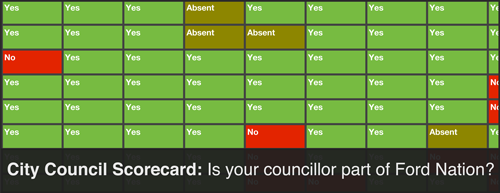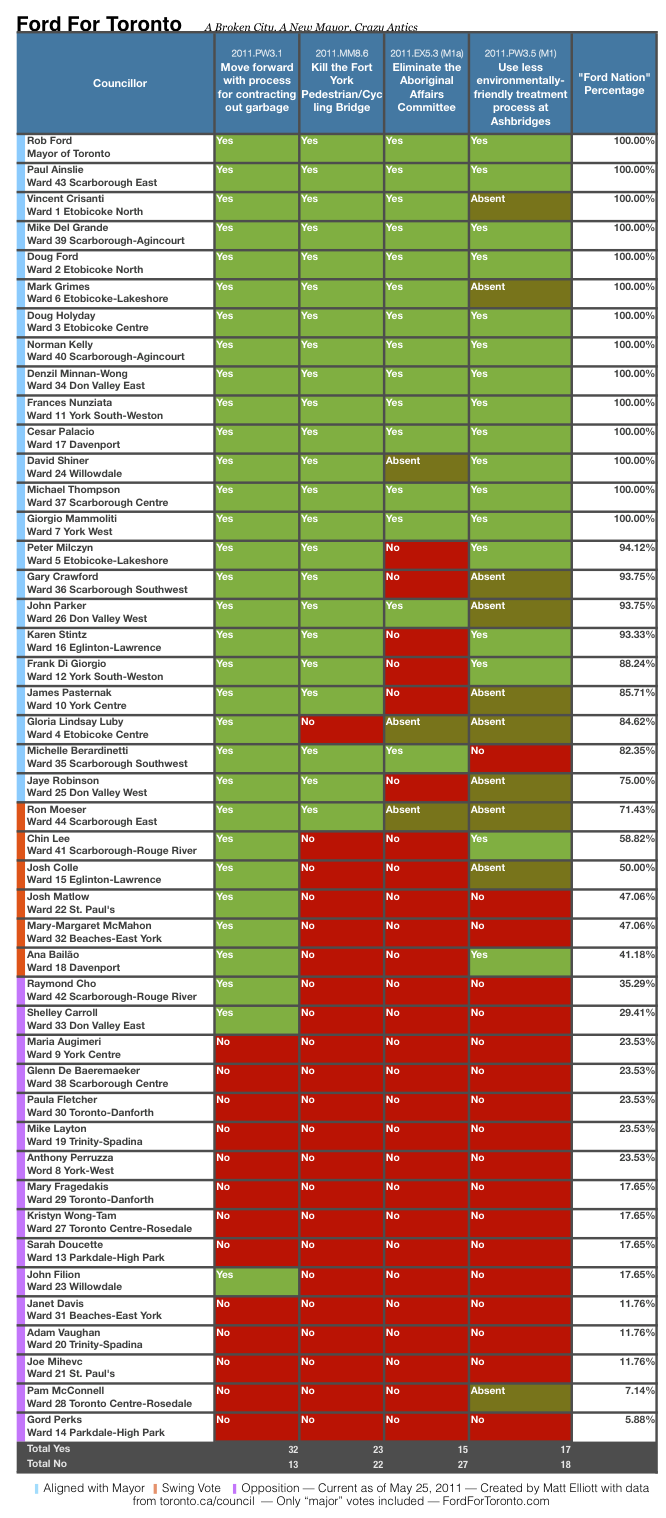Update: A version of this post is now available at OpenFile Toronto.
Confidential to Toronto city councillors still considering their vote on the elimination of the Jarvis Street Bike Lanes:Â So, hey, you’re one of those uncommitted councillors, probably hanging somewhere in the middle of the political spectrum. Â I understand that it’s a challenging position to be in. Even if you are a tad uncomfortable with the Rob Ford brand of conservatism, you can’t deny the mayor’s popularity coming out of his crushing victory in the October 2010 election. And if he won big in your ward, doesn’t that mean that your constituents expect you to follow the mayor’s lead and support his team on key matters? Isn’t that the definition of democracy?
Spoiler Alert: The answer to that question is no. I’d suggest that you were elected by your constituents with the promise that you would use your best judgment and work to do what’s best for your ward and for your city. Sometimes that will involve going against what’s perceived as popular. Sometimes that will involve going against the mayor.
So, all that said, you’re considering an upcoming item relating to the potential removal of the bike lanes on Jarvis, and I thought it might be helpful to know the ins and outs of the issue before the motion comes to a vote next week. That way, you won’t have to worry yourself with what direction that famous thumb is pointing. You can just vote based on what you feel is right.
And that’s all we could ever ask of you.
Weren’t the Jarvis bike lanes implemented by the previous council, over the objections of many of those who currently hold the balance of power?
No. The previous council voted to implement Item 2009.PW24.15 “Jarvis Street Streetscape Improvements – Class Environmental Assessment Study“ by a margin of 28-16. Four members of the current Executive Committee voted to implement the lanes.
But I heard the bike lanes were added at the last minute when the cycling community hijacked the debate?
Not really true. Though it is factual that the original plan for streetscape improvements on Jarvis Street did not include the provision for dedicated cycling lanes, the preferred option from that plan did include wider curb lanes that would have allowed for ‘sharrows’ to allow safer travel for cyclists.
A quick history lesson: Jarvis was, for much of its existence, a tree-lined residential street, home to many of the city’s wealthiest families. Its decline roughly coincides with a decision to better facilitate automobile traffic with the installation of a reversible centre lane on the stretch of roadway north of Queen Street to Mount Pleasant. This middle lane caused an increase to the speed of traffic and made for a hostile pedestrian environment. A 2005 traffic study concluded that, on Jarvis Street, “the pedestrian exposure to conflict is undesirable.” (pg. iii) The study recommended the removal of the reversible middle lane, which led to a staff report calling for streetscape improvements. Following advocacy efforts from the city’s cycling community, the recommended plan was altered to include the provision for cycling lanes, which were installed following the removal of the middle lane in 2010.
But don’t the results of the 2010 mayoral election mean that people want the lanes gone?
No. During his campaign, Mayor Ford told the Toronto Star that he would not remove the lanes: “It would be a waste of money to remove it if it’s already there, that is unless there was a huge public outcry in the area.” As far as “public outcry in the area” is concerned, Councillor Kristyn Wong-Tam, who supports the bike lanes, prevailed over opponents who vowed to remove the lanes in the municipal race last fall.
But Rob Ford says he’s gotten a lot of calls from people asking him to remove the lanes, shouldn’t we listen to them?
Absolutely. Consultation with the public is always important. Unfortunately, the item as amended by Councillor John Parker does not allow for further consultations regarding the future of Jarvis Street. In fact, a motion by Councillor Mike Layton that would have required proper community consultations before any changes are made to Jarvis Street was defeated at the Public Works & Infrastructure Committee by a vote of 4-2.
Wasn’t the original plan for Jarvis Street, which didn’t call for bike lanes, a better one?
It very well could have been. Jarvis Street suffered because the 2009 debate became entirely about bikes-versus-cars, when it rightly should have been about what’s best for Jarvis Street. But either way, that plan also called for the removal of the reversible middle lane, so impacts on traffic flow would have been similar.
As far as I know, there is still roughly $6-million allocated for beautification efforts on Jarvis Street, though I don’t think there’s a timeline attached to the work. Before removal of the lanes was put back on the table, Councillor Wong-Tam was also planning to spend $1-million of Section 37 funds to improve the street. Some of that money would have gone to synchronizing traffic lights to further improve traffic flow. All of this work is currently on hold, pending City Council’s decision.
Haven’t the bike lanes on Jarvis Street have resulted in significant traffic delays?
Not really. The bike lanes on Jarvis Street haven’t caused any significant delays. The removal of the reversible middle lane — which, you’ll remember, was going to happen anyway, bike lanes or no bike lanes — did result in a small increase in travel time at peak periods. Average travel times increased by approximately two minutes northbound and southbound in the a.m. rush, and by approximately three-to-five minutes in the p.m. rush.
Much of the increase in the p.m. rush is due to long queues as vehicles wait to turn left onto Gerrard Street. Traffic Services was set to install an advanced green phase this summer, which would alleviate much of the delay. At the very least, Council would be wise to wait for the results of a future traffic study, which should detail the effectiveness of the intersection tweak, before they take any further action on Jarvis Street.
Again, any delays are primarily due to the removal of the reversible lane. Removing the bike lanes could allow for the installation of dedicated left-turn lanes at major intersections, but that alone seems unlikely to substantially improve travel times. If council wants to explore that option further, I’d recommend commissioning a report.
What if I choose not to believe staff’s reported numbers?
You should panic. If that’s the case, I would suggest council has far bigger problems that they need to deal with immediately, and that those problems should take precedence over this issue. If you’re concerned that staff are being negligent or improper with the data they’re reporting to council, steps must be taken to improve that situation.
Of note: A recent news story relating to inaccurate cycling counts on John Street was due to a city-hired consultant using staff-reported numbers incorrectly.
Is it even feasible to re-add the fifth lane to Jarvis Street?
I don’t think so, no. Removing the bike lanes and installing some dedicated left-turn lanes is set to cost somewhere in the neighbourhood of $80,000. Reinstalling the reversible middle lane, on the other hand, would cost approximately $570,000. That’s a substantial financial outlay for the city, given current budgetary challenges.
Further, there are some relatively serious safety and design concerns relating to the previous configuration of Jarvis Street. Typically, the city recommends a minimum width of 3.3 metres for mid-block traffic lanes. Jarvis, in its five lane layout, had lane widths of only 3.1 metres. The 2005 Jarvis traffic study described the lane widths as ‘substandard.’ (pg 25)
Isn’t Jarvis kind of useless as a bike lane? It doesn’t even connect to anything.
It does, in fact, connect to existing bike lanes at Shuter Street. It will also connect to new separated bike lanes on Wellesley Street, should the new Downtown Bike Plan as proposed by Denzil Minnan-Wong be approved and built by this council.
Also, it’s important to remember that cyclists do not burst into flames should they come to the end of a bike lane. Jarvis also connects to numerous bicycle-friendly side streets, as well as popular destinations like St. Lawrence Market and Allan Gardens. The lanes are also directly adjacent to three BIXI bike rental stations.
But the plan for separated bike lanes on Sherbourne — only a block away — means Jarvis is no longer necessary for cyclists, right?
No. Just as Sherbourne and Jarvis are both useful for drivers and pedestrians depending on where one wants to go, cyclists use both routes. You would never argue that sidewalks are unnecessary on Jarvis Street because pedestrians can just use Sherbourne Street.
In addition, the Sherbourne Street bike lanes are currently in a shabby state of despair and require resurfacing. Given that council has not yet approved any aspect of the proposed plan for separated bike lanes downtown, removing Jarvis because of the existence of improved lanes on Sherbourne seems premature.
Finally, the installation of bike lanes on Jarvis have more than tripled the number of cyclists who use the route on a daily basis, which would indicate that there is significant demand for a safe bike route on the stretch.
Jarvis was one of the only working traffic arterials left downtown — how could making it slower be considered a good thing?
Jarvis is not simply a traffic arterial. It’s a street that has historically been residential, with a rich character all its own. In 2001, Jarvis was identified of one of seven “cultural corridors” in the City of Toronto. Thousands of people live and work on Jarvis Street, and more are coming as condo construction works it way east of Yonge Street. Jarvis Street is also home to schools — both a regular one, and Canada’s National Ballet School — and the aforementioned Allan Gardens, one of the city’s largest downtown parks.
As noted in remarks made by Councillor Giorgio Mammoliti, which came just before he voted to install the bike lanes, Jarvis is worth far more to the city as a vibrant place to live and work than it is as a simple traffic pipe. And given that the number of vehicle trips has not decreased even after the removal of the reversible fifth lane, it’s difficult to argue that Jarvis has lost utility as an arterial. It’s still doing the work it used to do, just in a slightly more civilized way.
What’s the big deal? Let’s just remove these things and move on with our lives.
Removing infrastructure should always be a big deal. Whether or not you agreed with the process that led to their installation in the first place, the Jarvis bike lanes are here. The city spent approximately $60,000 putting them in, and they are used by approximately 1,000 cyclists every day.
To justify their removal, councillors need to prove that the removal of this infrastructure is cost-effective. You’ll need to show that the money the city will spend removing these lanes will be recouped through increased economic activity. To do any less would be fiscally irresponsible.
 The votes added:
The votes added:



